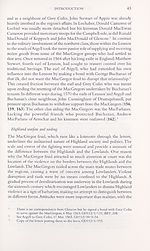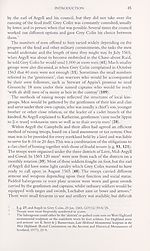Series 5 > Campbell Letters 1559-1583
(63) Page 44
Download files
Complete book:
Individual page:
Thumbnail gallery: Grid view | List view

44
CLAN CAMPBELL LETTERS
perceived gulf between the levels of violence much greater than the
actual one. This does not diminish the fact that they occupied different
points along the spectrum of violence. Especially in the unsettled times
of the ‘age of forays’, various factors made raiding and warfare endemic
within Highland society.1 The organizational structure of clan society
created groups of men whose main function was fighting. This trend had
been intensified within the Hebridean islands by the development of a
lucrative trade in mercenaries for an expanding Irish market.2 As can be
seen in the letters, a combination of fundamental social and economic
pressures with a strong military ethos and available manpower made
violence an accepted part of everyday life. Within the Highlands most of
that violence was small-scale and occurred when raiding. There were a
variety of types of foray. As a cattle raid’s main object was to seize cattle
or horses and then escape undetected, it did not normally lead to much
bloodshed. As well as the positive capture of resources for consumption
elsewhere, a raid might also be used negatively to destroy the enemy’s
food supplies. Crops were burnt and settlements laid waste to drive the
inhabitants from their lands. Some raids deliberately attacked people.They
normally targeted specific individuals or groups of kin, as in a bloodfeud.
Only rarely would a terror campaign be pursued with random killings
or the massacre of a whole community. Most raids were primarily
concerned with economic rather than with human targets. At its different
stages the MacGregor feud included all of these types of warfare, though
most of the raids were directed at seizing or destroying goods. It caused
economic dislocation over a large swathe of the central and southern
Highlands.3
The letters reveal much of the day-to-day organisation required to
mobilise troops in mid-sixteenth-century Scotland. Grey Colin did not
have sufficient military resources to prosecute the feud by himself. He
had to appeal for help from his chief, his fellow clansmen and other allies
within Argyll. Despite his complaints about lukewarm support, they sent
him substantial numbers of troops. The military effort was co-ordinated
1 ‘Linn nan Creach’, the traditional name for the period which followed the suppression
of the lordship of the Isles in 1493; R.A. Dodgshon,‘West Highland chiefdoms: a
study in redistributive exchange’, in R. Mitchison & P. Roebuck (eds.). Economy
and Society in Scotland and Ireland, 1500-1939 (Edinburgh, 1988); R.A. Dodgshon,
“‘Pretense of blude” and “place of thair duelling”: the nature of Scottish clans,
1500-1745’, in R.A. Houston & I.D. Whyte (eds.), Scottish Society, 1500-1800
(Cambridge, 1989); R.A. Dodgshon, From Chiefs to Landlords: Social and Economic
Change in the Western Highlands, 1493-1820 (Edinburgh, 1998), ch. 2.
2 G.A. Hayes-McCoy, Scots Mercenary Forces in Ireland, 1565-1603 (Dublin, 1937).
3 There are many memos in the Breadalbane collection which list the goods stolen
or property destroyed by the MacGregors, e.g. 30 June 1565, GDI 12/2/117/3/46;
12 June 1569, GD112/1/178,178a.
CLAN CAMPBELL LETTERS
perceived gulf between the levels of violence much greater than the
actual one. This does not diminish the fact that they occupied different
points along the spectrum of violence. Especially in the unsettled times
of the ‘age of forays’, various factors made raiding and warfare endemic
within Highland society.1 The organizational structure of clan society
created groups of men whose main function was fighting. This trend had
been intensified within the Hebridean islands by the development of a
lucrative trade in mercenaries for an expanding Irish market.2 As can be
seen in the letters, a combination of fundamental social and economic
pressures with a strong military ethos and available manpower made
violence an accepted part of everyday life. Within the Highlands most of
that violence was small-scale and occurred when raiding. There were a
variety of types of foray. As a cattle raid’s main object was to seize cattle
or horses and then escape undetected, it did not normally lead to much
bloodshed. As well as the positive capture of resources for consumption
elsewhere, a raid might also be used negatively to destroy the enemy’s
food supplies. Crops were burnt and settlements laid waste to drive the
inhabitants from their lands. Some raids deliberately attacked people.They
normally targeted specific individuals or groups of kin, as in a bloodfeud.
Only rarely would a terror campaign be pursued with random killings
or the massacre of a whole community. Most raids were primarily
concerned with economic rather than with human targets. At its different
stages the MacGregor feud included all of these types of warfare, though
most of the raids were directed at seizing or destroying goods. It caused
economic dislocation over a large swathe of the central and southern
Highlands.3
The letters reveal much of the day-to-day organisation required to
mobilise troops in mid-sixteenth-century Scotland. Grey Colin did not
have sufficient military resources to prosecute the feud by himself. He
had to appeal for help from his chief, his fellow clansmen and other allies
within Argyll. Despite his complaints about lukewarm support, they sent
him substantial numbers of troops. The military effort was co-ordinated
1 ‘Linn nan Creach’, the traditional name for the period which followed the suppression
of the lordship of the Isles in 1493; R.A. Dodgshon,‘West Highland chiefdoms: a
study in redistributive exchange’, in R. Mitchison & P. Roebuck (eds.). Economy
and Society in Scotland and Ireland, 1500-1939 (Edinburgh, 1988); R.A. Dodgshon,
“‘Pretense of blude” and “place of thair duelling”: the nature of Scottish clans,
1500-1745’, in R.A. Houston & I.D. Whyte (eds.), Scottish Society, 1500-1800
(Cambridge, 1989); R.A. Dodgshon, From Chiefs to Landlords: Social and Economic
Change in the Western Highlands, 1493-1820 (Edinburgh, 1998), ch. 2.
2 G.A. Hayes-McCoy, Scots Mercenary Forces in Ireland, 1565-1603 (Dublin, 1937).
3 There are many memos in the Breadalbane collection which list the goods stolen
or property destroyed by the MacGregors, e.g. 30 June 1565, GDI 12/2/117/3/46;
12 June 1569, GD112/1/178,178a.
Set display mode to:
![]() Universal Viewer |
Universal Viewer | ![]() Mirador |
Large image | Transcription
Mirador |
Large image | Transcription
Images and transcriptions on this page, including medium image downloads, may be used under the Creative Commons Attribution 4.0 International Licence unless otherwise stated. ![]()
| Scottish History Society volumes > Series 5 > Campbell Letters 1559-1583 > (63) Page 44 |
|---|
| Permanent URL | https://digital.nls.uk/128288548 |
|---|
| Description | Over 180 volumes, published by the Scottish History Society, containing original sources on Scotland's history and people. With a wide range of subjects, the books collectively cover all periods from the 12th to 20th centuries, and reflect changing trends in Scottish history. Sources are accompanied by scholarly interpretation, references and bibliographies. Volumes are usually published annually, and more digitised volumes will be added as they become available. |
|---|


